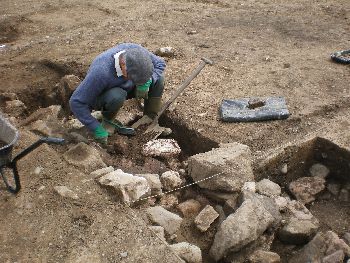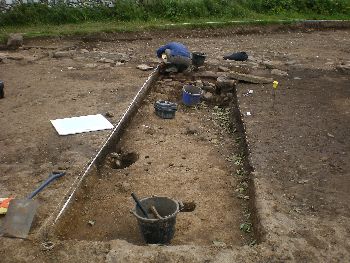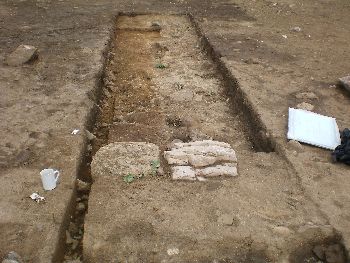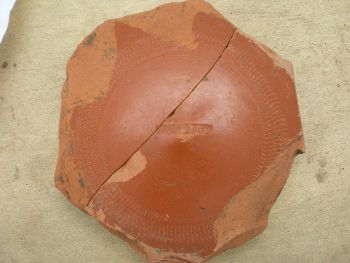Samian Pottery on Anglesey Roman Site
by Jenny Jones
(Cheshire)

Roman remains

Dig at Brynsiencyn

discovering island's past

Samian pottery Anglesey
At the weekend we saw amazing fragments of Samian pottery at an excavated Roman site near Brynsiencyn, close to Anglesey coastal path.
Down a small, narrow, winding lane which runs towards the Menai Strait, the Sea Zoo and Foel Farm, we found a group of archaeological experts and enthusiastic volunteers busy digging away in the corner of an otherwise unspectacular piece of farm land.
As we approached from the road we saw the massive mound on the left which had been formed by depositing the turf and top soil from the excavated area, a rough rectangular zone.
The team of archaelogists from the Gwynedd Archaeological Trust led by David Hopwell were very helpful when we approached them to ask about the background to the site.
They have been interested in this location for a few years and carried out a technical study called a geophysical survey to "map out" a rough picture of what was below the undisturbed grassy surface.
We saw an outline map which showed the extent of the Roman roads and buildings in the area. From the map we saw that there was a small road running past what appeared to be some buildings, heading towards the Menai Strait.
With the information from the geophysical survey the archaeologists led by David Hopwell became more confident about the strong possibility of this site being a Roman site.
They have revealed a building measuring about 20 by 6 metres, together with a 7 metre wide road. When we walked up to the actual dig we could see very clearly the outline of the road, with large boulders covered by smaller stones and gravel.
This was apparently how the Romans built their roads, and not just the Appian Way or Watling street, but even a small road on Anglesey or Mona (as it was called by the Romans).
As we walked around the remains of the building we could see how the soil was darker than the remainder of the site. The archaelogists believe this has been caused by the breakdown of wattle and daub when the building was burned down.
Across the water is the former Roman fort of Segontium in what is modern day Caernarfon. Speculation continues as to what if any connections there may have been between this settlement and the Roman fortress across the Menai Strait.
The really significant finding was numerous fragments of pottery, including the distinctive Samian pottery which was considered to be an exclusive design, and such "high status" works would only available to more affluent Romans.
Interestingly, among the ochre coloured pottery were other lower grade versions, made from local clays. Scratching away at the surface of the fragments showed the difference in colour between the darker Samian pottery and the lower quality clays of local provenance.
After carrying out some dating tests on the Samian fragments the archaeological team led by David Hopwell have concluded this Roman site dates back to around the 2nd century AD.
A close look at the base of one fragment reveals the name of the potter - LVPERCI - probably Lupercius, who worked around the 140-160 AD period. The pottery was probably made in the west Rhineland, possibly around what is today Cologne and Frankfurt.
The speculation goes on as to who lived here. Were they Romans or locals who traded with the occupiers?
We were so lucky to get a glimpse of the excavation because later that same afternoon (Saturday, 17 July 2010) the earth and topsoil was being returned and the site covered up.
We felt priviliged to have had the chance to see, albeit briefly, something so special from the ancient history of Anglesey with links to other parts of the Roman world.
After we left the site near the Menai Stait we were all thinking what this potter Lucerpius from the Rhine must have been like, what he looked like and if he ever came over to this island in Wales.
Are there any other fragments of Samian pottery buried in the area. Remember this was only a fraction of the area over which the Gwynedd Archaeological Trust carried out a geophysical survey.
Unfortunately, as funds are no longer available, no further excavations are planned.
It was a great day out and we learnt about something about Samian pottery and the Roman presence on Anglesey.
For more local news and stories, subscribe to our free Anglesey Today Newsletter here. It's as easy as 1-2-3!



